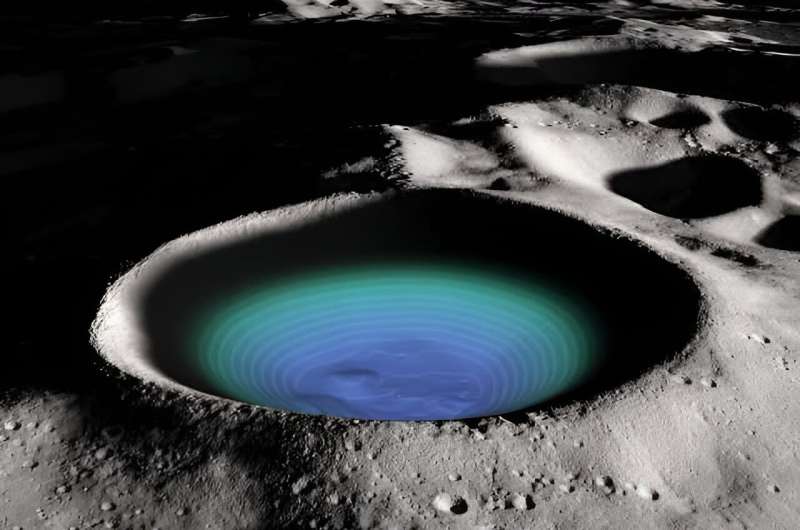This article has been reviewed according to Science X's editorial process and policies. Editors have highlighted the following attributes while ensuring the content's credibility:
fact-checked
trusted source
written by researcher(s)
proofread
With its latest moon mission success, China's space program has the US in its sights

June 25 2024 marked a new "first" in the history of spaceflight. China's robotic Chang'e 6 spacecraft delivered samples of rock back to Earth from a huge feature on the moon called the south pole–Aitken basin. After touching down on the moon's "far side," on the southern rim of the Apollo crater, Chang'e 6 came back with around 1.9kg of rock and soil, according to the China National Space Administration (CNSA).
The moon's south pole is designated as the location for the future China-led International Lunar Research Station (ILRS). This truly international endeavor has partners including Russia, Venezuela, South Africa and Egypt, and is being coordinated by an ad hoc kind of international space agency.
China has a strategic plan to build a space economy and become the world leader in this field. It intends to explore and extract minerals from asteroids and bodies such as the moon, and to use water ice and any other useful space resources available in our solar system.
China aims to explore the moon first, then the asteroids known as near-Earth objects (NEOs). It will then move on to Mars, the asteroids between Mars and Jupiter (known as the main belt asteroids), and Jupiter's moons, using the stable gravitational points in space known as Lagrange points for its space stations.
One of China's next steps in this strategy, the robotic Chang'e 7 mission, is expected to launch in 2026. It will land on the illuminated rim of the moon's Shackleton crater, very close to the lunar south pole. The rim of this large crater has a point that is constantly illuminated, in a region where the angle of the sun casts long shadows that obscure much of the landscape.
As a landing site, it is particularly attractive—not only because of the illumination, but the easy access it offers to the interiors of the crater. These shadowed craters hold vast reserves of water ice, which will be indispensable in building and operating the ILRS, as the water can be used for drinking water, oxygen and rocket fuel.
It is a bold move, as the US also has ambitions to establish bases at the moon's south pole—the Shackleton crater is prime real estate.
A later Chinese mission, Chang'e 8 (currently planned for no earlier than 2028), will aim to extract ice and other resources and demonstrate that it's possible to use them to support a human outpost. Both Chang'e 7 and 8 are considered part of ILRS and will set the scene for an impressive Chinese exploration program.
NASA is currently seeking further partners for the international agreement known as the Artemis Accords, established in 2020. These set out how resources on the moon should be used and to date, 43 countries have signed up.
However, the US Artemis program, which aims to return humans to the moon this decade, has been hit with delays due to technical issues.
It is normal to experience some delays in any complex new space program. The next mission, Artemis II, will carry astronauts around the moon without landing on it, but has been delayed until September 2025. Artemis III, which is due to ferry the first humans to the lunar surface since the Apollo era, is planned for no earlier than September 2026.
While this Artemis timeline could slip back further, China may deliver on its plans to land humans on the moon by 2030. Indeed, some commentators have wondered whether the Asian superpower could beat the US back to the moon.
Geopolitics in space
Will the US land humans on the the moon before the decade is out? I think so. Can China do the same before 2030? I am doubtful—but this is not the point. China's space program is systematically growing in a consistent and integrated way. Its missions appear not to have experienced the serious technical issues that other ventures have encountered—or perhaps we are just not being told about them.
What we know for sure is that China's current space station, Tiangong—which translates as "Heavenly Palace"—is operational at an average altitude of 400km.
There is a plan to have it permanently inhabited by a minimum of three taikonauts (Chinese astronauts) by the end of the decade. By the time this happens, the International Space Station, orbiting at the same altitude, will be decommissioned and sent on a fiery descent into the Pacific ocean.
Geopolitics is back as a force in space exploration in a way we perhaps haven't seen since the space race of the 1950s and '60s. It's quite possible that the US Artemis III mission and China's Chang'e 7 and Chang'e 8 missions will all want to land at the same location close to the Shackleton crater.
Only the crater rims can feasibly act as good landing sites, so there may be no choice but for China and the US to exchange plans, and to use this renewed phase of space exploration as a new era in diplomacy. While maintaining national priorities, the two superpowers, together with their partners, may have to agree on common principles when it comes to exploring the moon.
China has come a long way since its first satellite, DongFangHong 1, was launched on April 24 1970. China was not a player during the original space race to the moon in the 1960s and '70s. It certainly is now.
Provided by The Conversation
This article is republished from The Conversation under a Creative Commons license. Read the original article.![]()





















